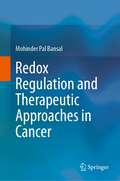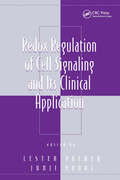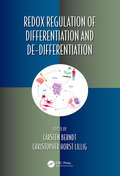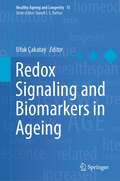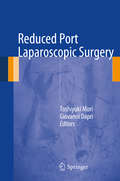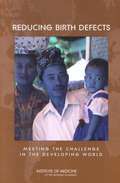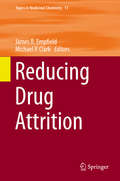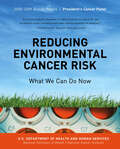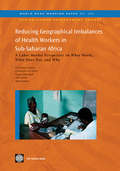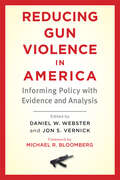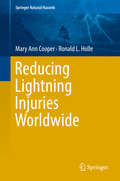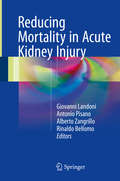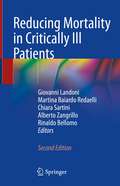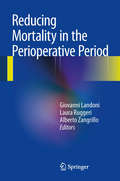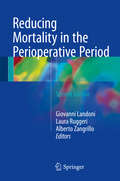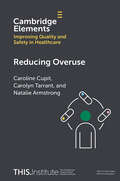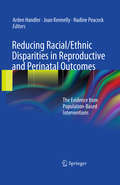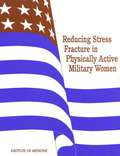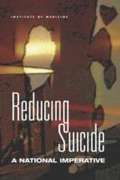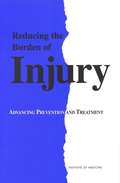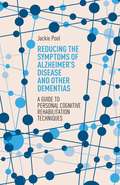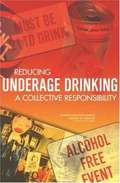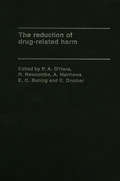- Table View
- List View
Redox Regulation and Therapeutic Approaches in Cancer
by Mohinder Pal BansalThis book aims to provide an association of the major redox-sensitive pathways and networks involved in cancer. The initial chapter of the book discusses basic information about oxidative stress, its generation, and regulation (redox regulation or redox homeostasis) via cell signaling in normal and cancer cells. The book also explores antioxidants and metabolic events in cancer cells compared to normal cells. It further covers the application of nanoparticles in redox regulation in cancer cells. The role of redox regulation in cancer therapy, its influence, and its involvement in programmed cell death (PCD), metastasis, immune system, p53, and cell cycle/DNA damage repair pathways have been discussed in separate chapters. It further reviews the importance of dietary phytochemicals in redox regulation in normal and cancer pathophysiology. Towards the end, the book focuses on the role of redox balance, especially in ROS-dependent cellular processes in cancer stem cells.
Redox Regulation of Cell Signaling and Its Clinical Application (Oxidative Stress and Disease)
by Lester Packer Junji YodoiPresents recent developments in the rapidly expanding field of redox regulation research. The book examines insights into intracellular communication and new techniques for diagnosing and treating diseases associated with oxidation and reduction. It focuses on important cellular mechanisms, such as redox reactions related to thioredoxin (TRX)/adult
Redox Regulation of Differentiation and De-differentiation (Oxidative Stress and Disease #48)
by Carsten Berndt Christopher Horst LilligCell differentiation and the development of multicellular organisms are processes of self-assembly, controlled and driven by signaling molecules and cascades including redox regulation. These reactions may have provided the energy for the first metabolic steps in the evolution of life. Today, redox modifications are established as important regulatory events in cellular functions including differentiation and development. Redox modifications of single cysteines regulate differentiation of stem cells, formation of functioning organs, and de-differentiation such as formation of cancer cells. Current cancer therapy is based on redox events as well and regeneration often reactivates developmental pathways. Understanding differentiation and de-differentiation on a molecular level is therefore a prerequisite for the continuing development of new medical therapies. This book summarizes the roles of redox regulation in development by bringing together different concepts and comparing similarities and differences between various cell types and species. An international team of contributors presents several new aspects of redox-regulated differentiation and de-differentiation, including aspects of redox medicine. Key Features Provides the first summary on this important topic Reviews redox-dependent development of model organisms and single organs Highlights the redox-regulated pathways important for differentiation processes Illustrates the potential of redox medicine Combines state-of-the-art knowledge in differentiation/development, aging/longevity, and repair/regeneration Written by leading experts in the field Related Titles Ayyanathan, K., ed. Cancer Cell Signaling: Targeting Signaling Pathways Toward Therapeutic Approaches to Cancer (ISBN 978-1-77188-067-1) Clarke, M. & J. Frampton. Stem Cells: Biology and Application (ISBN 9780-8153-4511-4) Lim, W. & B. Mayer. Cell Signaling: Principles and Mechanisms (ISBN 978-0-8153-4244-1) Wong, E., ed. Autophagy and Signaling (ISBN 978-0-367-65772-7)
Redox Signaling and Biomarkers in Ageing (Healthy Ageing and Longevity #15)
by Ufuk ÇakatayThis book aims to present the age-related alterations in redox signaling networks and their diagnostic biomarkers in aging cells using multidisciplinary approach. Establishing sensitive and specific biomarkers of dynamic redox homeostasis is crucially important in the development of effective antiaging and senolytic interventions. Recent years have seen tremendous advances in the understanding of redox signaling events which highlight the process of aging and age-related pathologies. A major challenge in biological aging research is developing reliable biomarkers to determine the consequences of disrupted redox signaling networks long before the clinical diagnosis of age-related diseases is made. Therefore, we have chosen to concentrate on aging-induced aberrant redox signaling networks, their biomarkers, and pathological consequences in this book. Although oxidation is a natural metabolic process, the imbalance in the level of oxidants and antioxidants causes oxidative stress and eventually leads to inflammatory conditions, diabetes, neurodegenerative diseases, and cancer. Novel redox-sensitive biomarkers for the evaluation of aging-induced proteinopathies such as amyloid ß and tau proteins in Alzheimer's disease, α-synuclein in Parkinson's disease, and islet amyloid polypeptides in type 2 diabetes mellitus recently drew the attention of researchers. Inside this textbook, readers will find comprehensive perspectives on the association between redox homeostasis and the aging process both at the molecular and clinical levels. Due to the inherent relationship between impaired metabolic activities and oxidative stress, the temporal interaction between intermediary metabolism and disturbed redox status can lead to greater susceptibility to aging-induced diseases and disorders, such as cardiovascular diseases, hypertension, and diabetes. This knowledge could be a key to continued research toward improving medication regimens such as in cancer and cardiovascular therapies, and procedural outcomes for patients. This book brings together current research evidence and knowledge on redox signaling and biomarkers in aging in chapters written by leading global experts in this rapidly evolving field. We hope that this textbook is of interest to a wide group of researchers, advanced students, scientifically curious non-specialist readers and clinicians alike.
Reduced Port Laparoscopic Surgery
by Toshiyuki Mori Giovanni DapriReduced port laparoscopic surgery is a fast-developing topic for the laparoscopic surgeon, with the emergence of a number of new techniques as well as new instruments. Edited by surgeons who have pioneered the single-incision approach, this volume provides extensive information for the beginning surgeon, examining different operation techniques and covering the advantages and pitfalls of reduced port laparoscopic surgery. In addition, the text provides the foundation for new ideas to further develop skills for the advanced laparoscopic surgeon.
Reducing Birth Defects: Meeting The Challenge In The Developing World
by Committee on Improving Birth OutcomesEach year more than 4 million children are born with birth defects. This book highlights the unprecedented opportunity to improve the lives of children and families in developing countries by preventing some birth defects and reducing the consequences of others. A number of developing countries with more comprehensive health care systems are making significant progress in the prevention and care of birth defects. In many other developing countries, however, policymakers have limited knowledge of the negative impact of birth defects and are largely unaware of the affordable and effective interventions available to reduce the impact of certain conditions. Reducing Birth Defects: Meeting the Challenge in the Developing World includes descriptions of successful programs and presents a plan of action to address critical gaps in the understanding, prevention, and treatment of birth defects in developing countries. This study also recommends capacity building, priority research, and institutional and global efforts to reduce the incidence and impact of birth defects in developing countries.
Reducing Drug Attrition
by James R. Empfield Michael P ClarkMedicinal chemistry is both science and art. The science of medicinal chemistry offers mankind one of its best hopes for improving the quality of life. The art of medicinal chemistry continues to challenge its practitioners with the need for both intuition and experience to discover new drugs. Hence sharing the experience of drug research is uniquely beneficial to the field of medicinal chemistry. Drug research requires interdisciplinary team-work at the interface between chemistry, biology and medicine. Therefore, the topic-related series Topics in Medicinal Chemistry covers all relevant aspects of drug research, e. g. pathobiochemistry of diseases, identification and validation of (emerging) drug targets, structural biology, drugability of targets, drug design approaches, chemogenomics, synthetic chemistry including combinatorial methods, bioorganic chemistry, natural compounds, high-throughput screening, pharmacological in vitro and in vivo investigations, drug-receptor interactions on the molecular level, structure-activity relationships, drug absorption, distribution, metabolism, elimination, toxicology and pharmacogenomics. In general, special volumes are edited by well known guest editors.
Reducing Environmental Cancer Risk: 2008-2009 Annual Report President's Cancer Panel
by LaSalle D. Leffall Margaret L. KripkeThe statistics are staggering: this year, 1.5 million Americans will be diagnosed with cancer—and more than 550,000 will die from the disease. One underlying cause of these high numbers may be the failure of the US government to regulate toxic substances. The President’s Cancer Panel Report examines the risks posed by the chemicals in our environment, and offers suggestions on what we can do to improve public health and safety. In the strongest words, it urges the President to “use the power of your office to remove the carcinogens and other toxins from our food, water, and air that needlessly increase health care costs, cripple our Nation’s productivity, and devastate American lives.”
Reducing Geographical Imbalances of Health Workers in Sub-Saharan Africa: A Labor Market Perspective on What Works, What Does Not, and Why
by Agnes Soucat Christophe Lemiere Negda Jahanshahi Ellen Smith Christopher HerbstThe human resources crisis in the health sector has been gathering attention on the global stage. To date, however, most of this attention has focused on shortages of health human resources (HRH) at the national level. At least as important are problems at the sub-national level. Massive geographic and skill mix imbalances are reflected in the perilous undersupply of HRH in most rural areas. Virtually all Sub-Saharan African countries suffer from significant geographic imbalances. Very little substantive information or documentation exists on the problem. Even less is known about the lessons from policies aimed at addressing urban-rural human resource imbalances, let alone experiences of Sub-Saharan Africa countries, with such policies. There also appears to be a disconnect between the objectives and efforts of policymakers on the one hand and the functioning of national health labor markets and labor market behavior on the other hand. This disconnect hinders policy effectiveness and the efficient utilization of resources intended to narrow urban-rural inequities. In Sub-Saharan Africa government policies, often limited to the management of public sector vacancies, appear to be elaborated, prescribed, and implemented independently of labor market considerations. Partly as a result, they are unable to effectively address urban-rural imbalances, which are an outcome of labor market dynamics. This report discusses and analyzes labor market dynamics and outcomes (including unemployment, worker shortages, and urban-rural imbalances of categories of health workers) from a labor economics perspective. It then use insights from this perspective as a basis for elaborating policy options that incorporate the underlying labor market forces. The goal of the study is to address undesirable outcomes (including urban-rural HRH imbalances) more effectively. The book is thus suitable for researchers, policy analysts and policy makers with an interest in understanding and improving the allocation of human resources for health in the developing world.
Reducing Gun Violence in America: Informing Policy with Evidence and Analysis
by Daniel W. Webster and Jon S. VernickOutstanding Academic Title, Choice MagazineThe staggering toll of gun violence—which claims 31,000 U.S. lives each year—is an urgent public health issue that demands an effective evidence-based policy response.The Johns Hopkins University convened more than 20 of the world's leading experts on gun violence and policy to summarize relevant research and recommend policies that are both constitutional and have broad public support. Collected for the first time in one volume, this reliable, empirical research and legal analysis will help lawmakers, opinion leaders, and concerned citizens identify policy changes to address mass shootings, along with the less-publicized gun violence that takes an average of 80 lives every day.Selected recommendations include:• Background checks: Establish a universal background check system for all persons purchasing a firearm from any seller. • High-risk individuals: Expand the set of conditions that disqualify an individual from legally purchasing a firearm. • Mental health: Focus federal restrictions on gun purchases by persons with serious mental illness on the dangerousness of the individual.• Trafficking and dealer licensing: Appoint a permanent director to ATF and provide the agency with the authority to develop a range of sanctions for gun dealers who violate gun sales or other laws. • Personalized guns: Provide financial incentives to states to mandate childproof or personalized guns. • Assault weapons and high-capacity magazines: Ban the future sale of assault weapons and the future sale and possession of large-capacity ammunition magazines.• Research funds: Provide adequate federal funds to the Centers for Disease Control and Prevention, National Institutes of Health, and National Institute of Justice for research into the causes and solutions of gun violence.The book includes an analysis of the constitutionality of many recommended policies and data from a national public opinion poll that reflects support among the majority of Americans—including gun owners—for stronger gun policies.
Reducing Inequalities in Health: A European Perspective
by Johan Mackenbach Martijntje BakkerSocio-economic inequalities in health are present to a greater or lesser extent in all European countries and the available data suggests that the health gap is increasing. Many studies have been conducted to explain inequalities in health and from them much has been learnt about the different contributory factors. However, in practice it seems hard to translate the knowledge of causes into effective interventions and policies. Reducing Inequalities in Health: a European Perspective:* brings together an unrivalled collection of contemporary data on successful policies and interventions* compares differences in approach in several European countries* includes recent evaluation studies* discusses conceptual issues for research* provides examples of good and bad practice in Europe* draws out the policy and research implications for the futureWith contributions from leading researchers in 14 different European countries, this book provides a comprehensive source of reference for the reader interested in what really works in the field of health promotion and what sort of policies reduce the health gap.
Reducing Lightning Injuries Worldwide (Springer Natural Hazards)
by Mary Ann Cooper Ronald L. HolleThis book is a resource for understanding why Lightning continues to be a major health hazard, especially in the developing world, and equips researchers, governments, and public health advocates with the knowledge and techniques needed to reduce lightning casualties worldwide.
Reducing Mortality in Acute Kidney Injury
by Giovanni Landoni Antonio Pisano Alberto Zangrillo Rinaldo BellomoThis book describes the techniques, strategies, and drugs that have been demonstrated by at least one paper published in a peer-reviewed journal to significantly influence survival in patients with or at risk for acute kidney injury. Each chapter focuses on a specific intervention. The scope is accordingly wide, with coverage of topics as diverse as the type, timing, and dose of renal replacement therapy (RRT), anticoagulation and specific indications for RRT, perioperative hemodynamic optimization, fluid balance, diuretics, colloids, fenoldopam, terlipressin, N-acetylcysteine, and vasopressin. A variety of settings are considered, including critically ill patients, cardiac surgery, and hepatic and hematologic disorders. The topic selection was made using a democracy-based approach in which hundreds of specialists from dozens of countries expressed, via the web, whether they agreed with these topics and whether they used the techniques in their daily clinical practice. The clear text is supported by "how to do" sections and "key point" boxes that provide easily accessible practical information. The book will be of interest for a wide variety of specialists, including intensivists, nephrologists, emergency doctors, and anesthesiologists.
Reducing Mortality in Critically Ill Patients
by Giovanni Landoni Martina Baiardo Redaelli Chiara Sartini Alberto Zangrillo Rinaldo BellomoThe 2nd edition of this book describes the recent techniques, strategies, and drugs that have been demonstrated by multicenter randomized trials to influence survival in critically ill, defined as those who have acute failure of at least one organ, due to either a pathological condition or a medical intervention, and require intensive care treatment. Each chapter focuses on a specific procedure, device, or drug. The scope is accordingly wide, with coverage of topics as diverse as noninvasive mechanical ventilation, protective ventilation, prone positioning, intravenous salbutamol in ARDS, high-frequency oscillatory ventilation, mild hypothermia after cardiac arrest, daily interruption of sedatives, tranexamic acid, diaspirin cross-linked hemoglobin, albumin, growth hormone, glutamine supplementation, tight glucose control, supranormal oxygen delivery, and hydroxyethyl starch in sepsis. The topics selection was performed with the help of hundreds of specialists from dozens of countries; they expressed via web if they agreed or not with these topics and if they used them in their daily clinical practice. The clear text is supported by "how to do" sections and "key point" boxes that provide easily accessible practical information. Written by acknowledged international experts, Reducing Mortality in Critically Ill Patients is of interest for a wide variety of specialists, including intensivists, emergency doctors, and anesthesiologists.
Reducing Mortality in the Perioperative Period
by Giovanni Landoni Laura Ruggeri Alberto ZangrilloThis book describes the techniques, strategies, and drugs that have been demonstrated by well-documented randomized trials to influence survival in the perioperative setting. It takes into consideration all types of adult surgery and will be relevant to the evaluation of any patient undergoing an operative procedure. Each chapter focuses on a specific procedure, device, or drug. The scope is accordingly wide, with coverage of topics as diverse as chlorhexidine oral rinse, clonidine therapy, insulin infusion, intra-aortic balloon pump support, leukodepletion, neuraxial anesthesia, and noninvasive respiratory support, to name but a few. In addition, the risks and benefits of using a web-based consensus process (as in this book) to identify effective means of reducing perioperative mortality are discussed. The clear text is supported by "how to do" sections and "key points" boxes that provide easily accessible practical information. Written by acknowledged international experts, Reducing Mortality in the Perioperative Period will be of interest for a wide variety of specialists, including surgeons, cardiologists, anesthesiologists, and intensivists.
Reducing Mortality in the Perioperative Period
by Giovanni Landoni Laura Ruggeri Alberto ZangrilloThis second edition presents the first update on a consensus process during which all evidence from the literature with a survival benefit in the perioperative period was gathered, and in which 500 physicians from 61 countries worked to confirm the findings. Perioperative morbidity and mortality currently represent a public health problem, as mortality alone is 1-4% in Western countries. Surprisingly, randomized evidence of survival benefit in the perioperative period is available for only 12 topics, while two drugs have been demonstrated to increase mortality. This book offers a complete description of each topic with updated evidence from the literature. Each chapter deals with a specific drug or technique and is structured into the following: background knowledge, main evidence from the literature, and a practical how-to section. Lastly, the book describes in detail the consensus process used, which served to reinforce the systematic review and which is currently being used and improved in other settings with growing success. Written by respected international experts, Reducing Mortality in the Perioperative Period, 2nd ed. will be of interest to a wide variety of specialists, including surgeons, anesthesiologists, intensivists and cardiologists.
Reducing Overuse (Elements of Improving Quality and Safety in Healthcare)
by Caroline Cupit Carolyn Tarrant Natalie ArmstrongOveruse has become a major issue of healthcare quality, safety, and sustainability around the world. In this Element, the authors discuss concepts, terminology, and the history of concerns. They show how interventions to address overuse target multiple drivers. They highlight successes and promising approaches, but also challenges in generating and using evidence about overuse. They emphasise that different stakeholder perceptions of value must be recognised. System-level efforts to restrict access to services have created tensions between stakeholder groups and stimulated politicised debates about rationing. They argue for clear articulation of priorities, problem definition, mechanisms for interventions, and areas of uncertainty. Policy-makers should prioritise transparency, be alert to inequalities as they seek to reduce overuse, and consider how to balance controlling use with enabling clinicians to respond to individual circumstances. The complexity of the drivers and possible solutions to overuse require the use of multiple research methods, including social science studies. This title is also available as Open Access on Cambridge Core.
Reducing Racial/Ethnic Disparities in Reproductive and Perinatal Outcomes
by Joan Kennelly Arden Handler Nadine PeacockAmong women's health concerns, reproductive issues, both prenatal and postpartum, hold particular prominence. Yet despite the many programs dedicated to improving women's reproductive health, maternal and infant morbidity and mortality rates in minority communities remain unchanged--or have increased. Confronting this alarming statistic head-on, Reducing Racial/Ethnic Disparities in Reproductive and Perinatal Outcomes is the first book systematically examining public health interventions designed toward meeting this important and elusive goal. Its contributors offer the best thinking and practice on this complicated topic, clarifying the relationship between evidence-based medicine and evidence-based public health and its potential for increasing parity, considering interventions in the multiple contexts of women's lives, reviewing the evidence base for each program or initiative featured, and describing methodologies for evaluating interventions. The resulting volume advocates for an integrative lifespan approach, including topics related to: Family planning STI and HIV/AIDS screening and treatment Smoking cessation and reducing exposure to environmental smoke Preconceptional well-woman care Depression screening and treatment Labor/delivery approaches and intrapartum care Emerging prenatal care interventions, from centering pregnancy to doula support For professionals and graduate students in psychiatry, psychology, sociology, women's health, and public health, Reducing Racial/Ethnic Disparities in Reproductive and Perinatal Outcomes reframes a set of ongoing issues and guides the reader toward state-of-the-art solutions.
Reducing Stress Fracture in Physically Active Military Women
by Subcommittee on Body Composition Nutrition Health of Military WomenThe incidence of stress fractures of the lower extremities during U.S. military basic training is significantly higher among female military recruits than among male recruits. The prevalence of this injury has a marked impact on the health of service personnel and imposes a significant financial burden on the military by delaying completion of the training of new recruits. In addition to lengthening training time, increasing program costs, and delaying military readiness, stress fractures may share their etiology with the longer-term risk of osteoporosis.As part of the Defense Women's Health Research Program, this book evaluates the impact of diet, genetic predisposition, and physical activity on bone mineral and calcium status in young servicewomen. It makes recommendations for reducing stress fractures and improving overall bone health through nutrition education and monitored physical training programs. The book also makes recommendations for future research to evaluate more fully the effects of fitness levels, physical activities, and other factors on stress fracture risk and bone health.
Reducing Suicide: A National Imperative
by Committee on Pathophysiology Prevention Of Adolescent Adult SuicideEvery year, about 30,000 people die by suicide in the U.S., and some 650,000 receive emergency treatment after a suicide attempt. Often, those most at risk are the least able to access professional help.Reducing Suicide provides a blueprint for addressing this tragic and costly problem: how we can build an appropriate infrastructure, conduct needed research, and improve our ability to recognize suicide risk and effectively intervene. Rich in data, the book also strikes an intensely personal chord, featuring compelling quotes about people’s experience with suicide. The book explores the factors that raise a person’s risk of suicide: psychological and biological factors including substance abuse, the link between childhood trauma and later suicide, and the impact of family life, economic status, religion, and other social and cultural conditions. The authors review the effectiveness of existing interventions, including mental health practitioners’ ability to assess suicide risk among patients. They present lessons learned from the Air Force suicide prevention program and other prevention initiatives. And they identify barriers to effective research and treatment.This new volume will be of special interest to policy makers, administrators, researchers, practitioners, and journalists working in the field of mental health.
Reducing the Burden of Injury: Advancing Prevention and Treatment
by Institute of MedicineInjuries are the leading cause of death and disability among people under age 35 in the United States. Despite great strides in injury prevention over the decades, injuries result in 150,000 deaths, 2.6 million hospitalizations, and 36 million visits to the emergency room each year.Reducing the Burden of Injury describes the cost and magnitude of the injury problem in America and looks critically at the current response by the public and private sectors, including: Data and surveillance needs.Research priorities.Trauma care systems development.Infrastructure support, including training for injury professionals.Firearm safety.Coordination among federal agencies. The authors define the field of injury and establish boundaries for the field regarding intentional injuries. This book highlights the crosscutting nature of the injury field, identifies opportunities to leverage resources and expertise of the numerous parties involved, and discusses issues regarding leadership at the federal level.
Reducing the Symptoms of Alzheimer’s Disease and Other Dementias: A Guide to Personal Cognitive Rehabilitation Techniques
by Jackie PoolThis innovative new book sets out practical guidance for people with dementia, their families and carers on reducing the symptoms of Alzheimer's disease and other dementias. Applying a 'rementia' based approach to dementia care, Jackie Pool shows how therapeutic cognitive rehabilitation techniques can be used to reduce symptoms of dementia and ultimately improve quality of life for people living with dementia.Covering topics such as nutrition, stress, communication, memory and sleep, it provides all the tools and information necessary to build a personalised and flexible self-care plan which will improve and sustain quality of life. By clearing away the myths and stigma surrounding dementia, this book creates room for cooperation, creativity and hope.
Reducing Tobacco-Related Cancer Incidence and Mortality
by Erin Balogh Sharyl J. Nass Institute of Medicine National Cancer Policy Forum Board on Health Care Services Margie PatlakTobacco use is the leading cause of preventable death in United States, causing more than 440,000 deaths annually and resulting in $193 billion in health-related economic losses each year--$96 billion in direct medical costs and $97 billion in lost productivity. Since the first U.S. Surgeon General's report on smoking in 1964, more than 29 Surgeon General's reports, drawing on data from thousands of studies, have documented the overwhelming and conclusive biologic, epidemiologic, behavioral, and pharmacologic evidence that tobacco use is deadly. This evidence base links tobacco use to the development of multiple types of cancer and other life-threatening conditions, including cardiovascular and respiratory diseases. Smoking accounts for at least 30 percent of all cancer deaths, and 80 percent of lung cancer deaths. Despite the widespread agreement on the dangers of tobacco use and considerable success in reducing tobacco use prevalence from over 40 percent at the time of the 1964 Surgeon General's report to less than 20 percent today, recent progress in reducing tobacco use has slowed. An estimated 18.9 percent of U.S. adults smoke cigarettes, nearly one in four high school seniors smoke, and 13 percent of high school males use smokeless tobacco products. In recognition that progress in combating cancer will not be fully achieved without addressing the tobacco problem, the National Cancer Policy Forum of the Institute of Medicine (IOM) convened a public workshop, Reducing Tobacco-Related Cancer Incidence and Mortality, June 11-12, 2012 in Washington, DC. In opening remarks to the workshop participants, planning committee chair Roy Herbst, professor of medicine and of pharmacology and chief of medical oncology at Yale Cancer Center and Smilow Cancer Hospital, described the goals of the workshop, which were to examine the current obstacles to tobacco control and to discuss potential policy, outreach, and treatment strategies that could overcome these obstacles and reduce tobacco-related cancer incidence and mortality. Experts explored a number of topics, including: the changing demographics of tobacco users and the changing patterns of tobacco product use; the influence of tobacco use on cancer incidence and cancer treatment outcomes; tobacco dependence and cessation programs; federal and state level laws and regulations to curtail tobacco use; tobacco control education, messaging, and advocacy; financial and legal challenges to tobacco control efforts; and research and infrastructure needs to support tobacco control strategies, reduce tobacco related cancer incidence, and improve cancer patient outcomes. Reducing Tobacco-Related Cancer Incidence and Mortality summarizes the workshop.
Reducing Underage Drinking: A Collective Responsibility
by National Research Council Institute of Medicine of the National AcademiesAlcohol use by young people is extremely dangerous - both to themselves and society at large. Underage alcohol use is associated with traffic fatalities, violence, unsafe sex, suicide, educational failure, and other problem behaviors that diminish the prospects of future success, as well as health risks – and the earlier teens start drinking, the greater the danger. Despite these serious concerns, the media continues to make drinking look attractive to youth, and it remains possible and even easy for teenagers to get access to alcohol. Why is this dangerous behavior so pervasive? What can be done to prevent it? What will work and who is responsible for making sure it happens? Reducing Underage Drinking addresses these questions and proposes a new way to combat underage alcohol use. It explores the ways in which may different individuals and groups contribute to the problem and how they can be enlisted to prevent it. Reducing Underage Drinking will serve as both a game plan and a call to arms for anyone with an investment in youth health and safety.
The Reduction of Drug-Related Harm
by P. A. O’Hare R. Newcombe A. Matthews E. C. Buning E. DruckerFirst Published in 1992. Routledge is an imprint of Taylor & Francis, an informa company.
